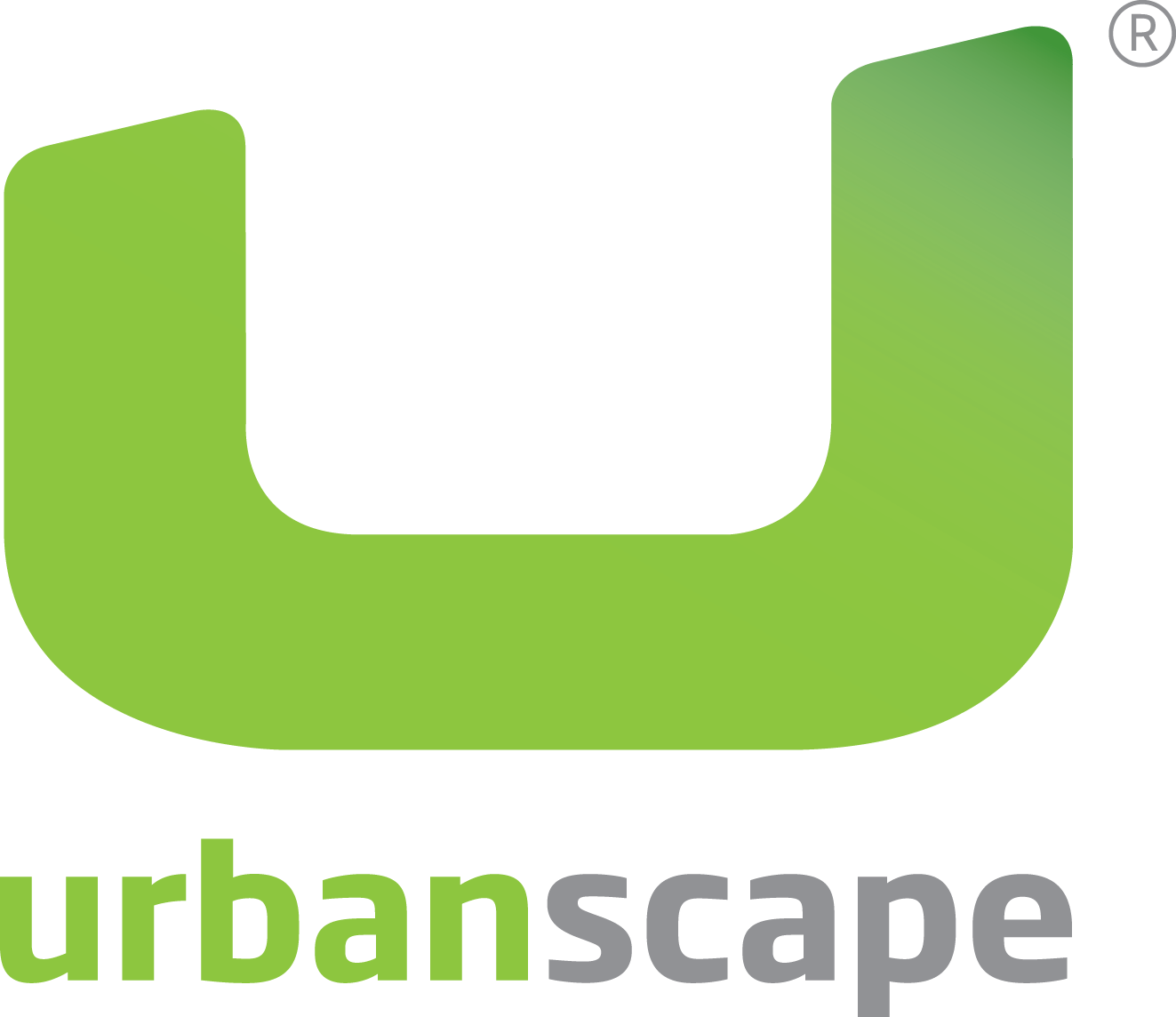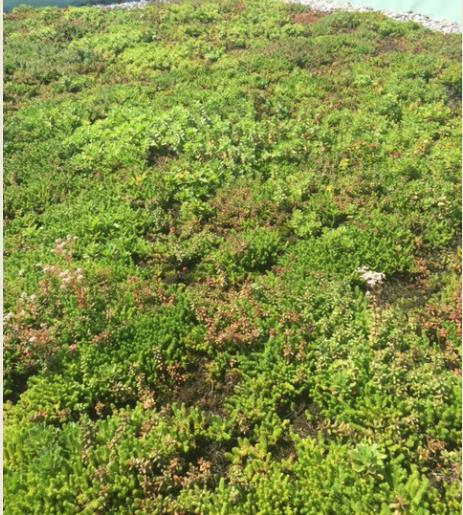Designers, investors, project owners and other stakeholders often have questions about the maintenance of green roofs. It’s important to be realistic, and to take into account all of the many aspects of this question.
Let’s start with the most important one: what does the owner want and expect from his green roof? When someone decides for an extensive green roof solution it’s clear that use of green roof spaces for recreational and leisure activities is rather limited. Is the decision then related to the owner’s personal attitude; their hope of making a greener world, of reducing CO2 emissions? Or did the owner recognise the possibilities for energy savings in cooling and heating the building? Whatever the reason, the roof should be kept in good condition if the owner wants the green roof to deliver optimal water retention, energy conservation, a naturally beautiful appearance and more. For this healthy, vigorous plant growth is necessary.
How much extra effort do I need to put into my green roof?
In general, extensive green roofs require little maintenance. Very often, such roofs are only accessible for maintenance, and further, they are often not visible. Yearly inspection is recommended, as in the case of any roof. During such a visit the gutters should be cleaned, the inspection boxes and outlets checked, any competitive weeds removed, basic fertilisation with slow-release fertiliser should be done, and overall vegetation performance should be monitored.
So, maintenance is closely connected with the owner’s expectations, the particular system chosen and climatic conditions. If the visual aspect is particularly important, one should think about irrigation or regular watering, which will produce a lush sedum roof. Differences related to the roof’s exposed position and shallow root system becomes particularly evident with watering. According to Meyer (2014), this visual preference is particularly typical for the US market.
Photo 1: Roof without fertigation in dry climate zone:
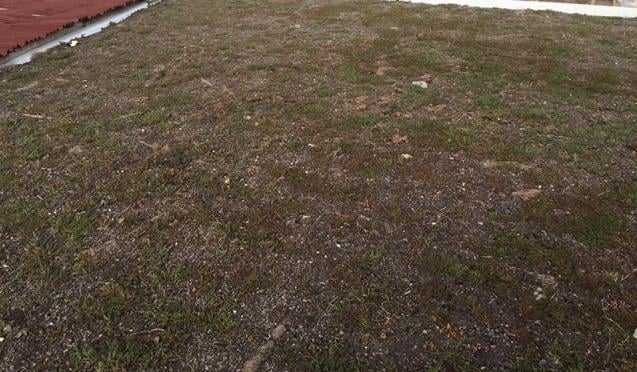
Photo 2: Irrigated roof with annual fertilisation with slow release fertiliser, in dry climate zone:
Is the maintenance regime consistent or does it change as the roof ages?
Maintenance of the roof depends on several factors, including the age of the roof. The roof is more vulnerable in the early stages. If installed in mild weather and the vegetation mats are solidly rooted as soon as possible, maintenance should not be particularly extensive. The roof should reach maturity after one or two growing seasons, depending on the planting system. Until the roof has reached maturity, all weeding, fertilisation and watering should be performed carefully, with close regard for the plants, the climate and substrate requirements. Later, yearly inspection as described above should be sufficient.
In cases where a green roof irrigation system is installed, a regular, supplementary check of the system is part of the maintenance routine – which means turning the system on and off at the beginning and end of the irrigation season; and the system must be blown out before the first freeze of the fall.
How much water does an extensive sedum roof need?
There’s no room for generalization here – too many factors influence every single green roof and its vegetation needs. Let us first look at some research data. Trials performed in greenhouses produce the following conclusions:
1. After the fourth month, Sedum spp. survived and maintained active photosynthetic metabolism. Furthermore, when Sedum was watered after 28 days of drought, chlorophyll fluorescence values recovered to values characteristic of the regime of two days between watering. As this ability is unique for CAM plants (which makes them suitable for extensive green roofs), the non-CAM plants required watering every other day in order to survive and maintain active growth and development.
2. Deeper substrates do provide additional growth with sufficient water, but one should keep in mind they also require additional irrigation owing to the higher evapotranspiration rates resulting from greater biomass. Over the 88-day study, water was required at least once every 14 days to support growth in green roof substrates with a 2 cm substrate depth. However, substrates with a 6 cm substrate depth could make do with watering only once every 28 days. Although vegetation was still viable after 88 days of drought, water should be applied at least once every 28 days for typical green roof substrates, and more frequently for shallower substrates to sustain growth. The ability of Sedum to withstand extended drought conditions makes it ideal for shallow green roof systems.
3. As these trials are performed in greenhouses, where evaporation and other external effects are minimised, what do we see in practice, in the harsh environment of the roof? We do need, certainly, to provide sufficient water for successful initial rooting of the plants (with quantities depending on natural rainfall, humidity, temperature, condition of the plants, roof slope). Once regular growth has been established regular watering is not necessary, with the exception of extended dry periods. The amount of irrigation therefore depends on the specific water requirements of the vegetation and local climatic and roof conditions, just as in a regular garden on the ground.
Rooting sedum blankets in the Urbanscape Green roll is fast and easy owing to the open structure of the blanket, with the blanket holding a significant amount of water that is easily made available for plant uptake. The rooting period can vary according to the climate and the availability of both water and nutrients.
a) Mini-rooting two weeks after installation
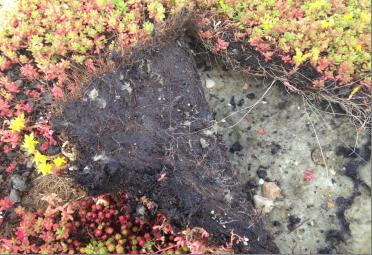
b) Complete rooting into the Urbanscape green roll two months after installation
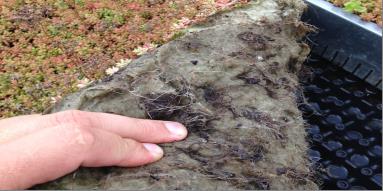
If the plants are given the right food in spring, an established sedum roof will more or less care for itself without the need for additional watering (with the exception of drought or prolonged dry, warm or windy periods).
To learn more about why sedum plants are the best option to be used on extensive green roofs and how it improves biodiversity, read our blog here!
Conclusion: Too much water is worse than too little
The fact is, too much water is worse for sedum plants than too little. Sedums are not demanding in terms of water and nutrients, and too much water can encourage weeds.
In case you are interested in Urbanscape Green Roof Systems and green roof benefits, download our brochure below:
We also offer you the 2 tools, which can help you designing Urbanscape Green Roof Systems:
Follow us also on Twitter, LinkedIn or YouTube!
Sources:
- [1] Meyer, M., 2014. Green roof irrigation: Considerations and Case Studies. Cities Alive. 12th Annual Green roof and Wall Conference, Nashville.
- [2] Durhman, A.K., D.B. Rowe, and C.L. Rugh. 2006. Effect of watering regimen on chlorophyll fluorescence and growth of selected green roof plant taxa. HortScience 41(7):1623-1628.
- [3] VanWoert, N.D, D.B. Rowe, J.A. Andresen, C.L. Rugh, and L. Xiao. 2005. Watering regime and green roof substrate design affect Sedum plant growth. HortScience 40(3):659-664.
